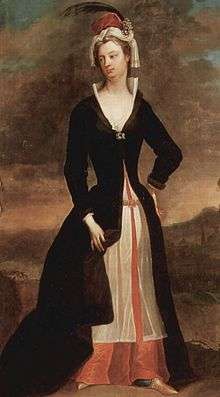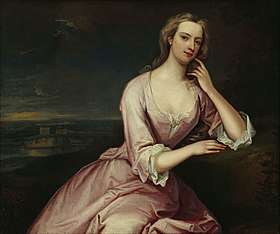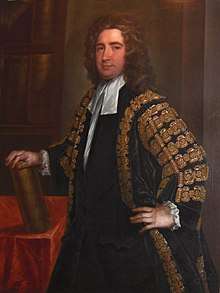Charles Jervas
Charles Jervas (also Jarvis; c. 1675 – 2 November 1739) was an Irish portrait painter, translator, and art collector of the early 18th century.[1]

Early life
Born in Clonlisk, County Offaly,[2] Ireland around 1675, the son of John Jervas and Elizabeth, daughter of Captain John Baldwin of Shinrone Castle & Corolanty, High Sheriff of County Offaly. Jervas studied in London, England as an assistant under Sir Godfrey Kneller between 1694 and 1695.
After selling a series of small copies of the Raphael Cartoons circa 1698 to Dr. George Clarke of All Souls College, Oxford, the following year he travelled to Paris and Rome (while financially supported by Clarke and others) remaining there for most of the decade before returning to London in 1709 where he found success as a portrait painter.
Career

Painting portraits of the city's intellectuals, among them such personal friends as Jonathan Swift and the poet Alexander Pope (both now in the National Portrait Gallery, London), Charles Jervas became a popular artist often referred to in the works of literary figures of the period.
Jervas gave painting lessons to Pope at his house in Cleveland Court, St James's, which Pope mentions in his poem, To Belinda on the Rape of the Lock, written 1713, published 1717 in 'Poems on Several Occasions'.
Pope's verse Epistle to Mr Jervas, written circa 1715, was published in the 1716 edition of John Dryden's 1695 translation of Fresnoy's Art of Painting (Charles Alphonse Du Fresnoy's De arte graphica, 1668).
With his growing reputation, Jervas succeeded Kneller as Principal Painter in Ordinary to King George I in 1723, and continued to live in London until his death in 1739.[3][4]

His translation of Cervantes' novel Don Quixote, published posthumously in 1742 as being made by Charles "Jarvis" – because of a printer's error – has since come to be known as "the Jarvis translation". Jervas was first to provide an introduction to the novel including a critical analysis of previous translations of Don Quixote. It has been highly praised as the most accurate translation of the novel up to that time, but also strongly criticised for being stiff and humourless, although it went through many printings during the 19th century.
Legacy
As principal portraitist to the King of England, Jervas was known for his vanity and luck, as mentioned in the Imperial Biographical Dictionary, "He married a widow with $20,000; and his natural self-conceit was greatly encouraged by his intimate friend [Alexander] Pope, who has written an epistle full of silly flattery."
According to one account, after comparing a painting he had copied from Titian, he was said to have stated "Poor little Tit, how he would starve !".
Upon being told that Jervas had set up a carriage with four horses, Kneller replied: "Ach, mein Gott, if his horses do not draw better than he does, he will never get to his journey's end."
Notes
- National Gallery of Ireland; Figgis, N.; Rooney, B. (2001). Irish Paintings in the National Gallery of Ireland. Irish Paintings in the National Gallery of Ireland. The Gallery. p. 299. ISBN 978-0-903162-70-8. Retrieved 1 May 2019.
... He died at his house in London on 2 November 1739.
- Denys Sutton, Aspects of Irish Art. National Gallery of Ireland. Cahill & Co., 1974. p. 109. Retrieved 18 March 2008.
- Moore, A.W.; Crawley, C.; Norwich Castle Museum (1992). Family & friends: a regional survey of British portraiture. HMSO. p. 34. ISBN 978-0-11-701506-7. Retrieved 1 May 2019.
The archives at Raynham contain an account for work carried out by Charles Jervas, reputedly Sir Robert Walpole's favourite painter and Principal Painter to the King since 1723.
- Rogers, D.B.P.L.A.P.; Rogers, P.; Rosenberg, M. (2004). The Symbolic Design of Windsor-Forest: Iconography, Pageant, and Prophecy in Pope's Early Work. G – Reference, Information and Interdisciplinary Subjects Series. University of Delaware Press. p. 78. ISBN 978-0-87413-837-5. Retrieved 1 May 2019.
References
- Webb, Alfred. A Compendium of Irish Biography: Comprising Sketches of Distinguished Irishmen and of Eminent Persons Connected with Ireland by Office or by Their Writings, New York: Lemma Publishing Corporation, 1970.
External links
| Wikimedia Commons has media related to Charles Jervas. |